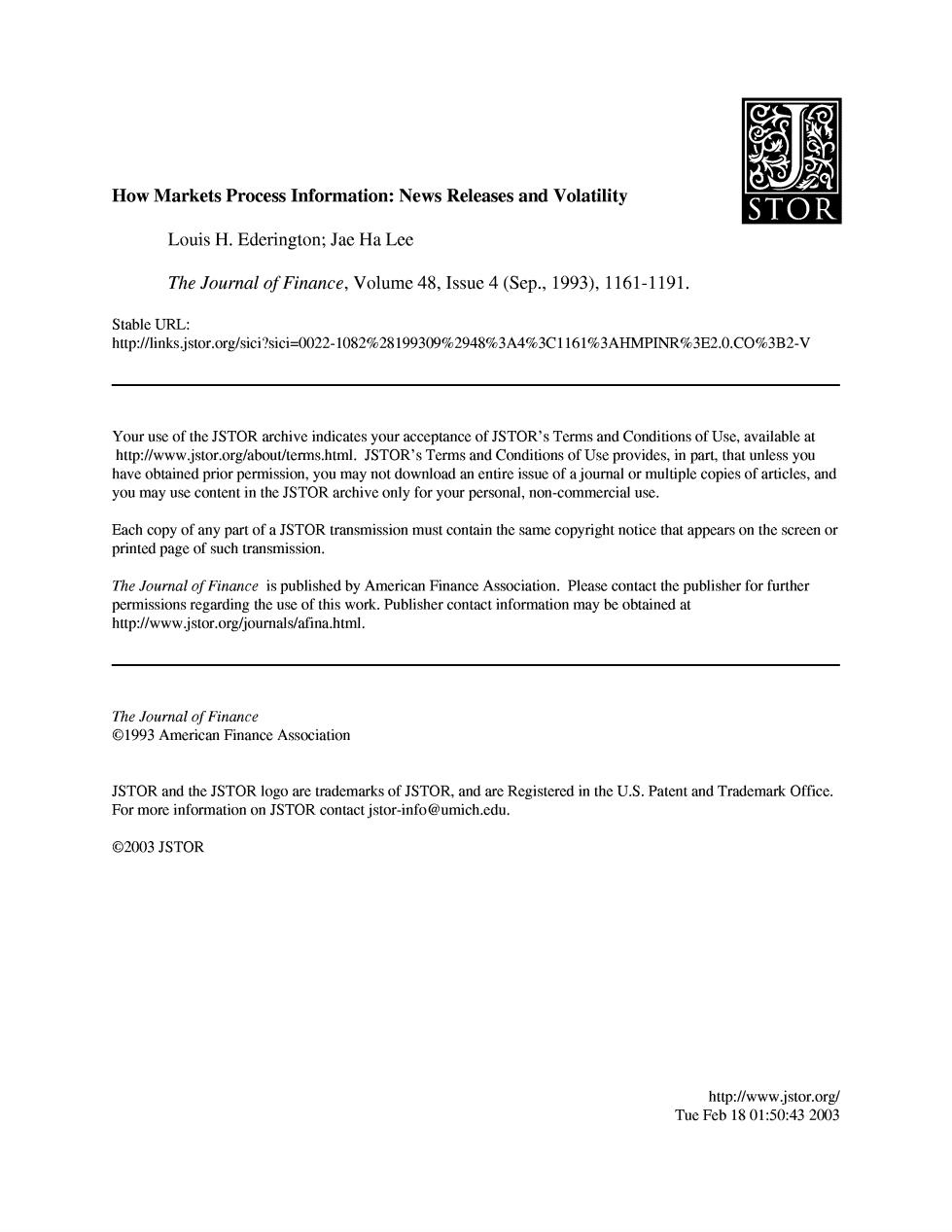
How Markets Process Information:News Releases and Volatility T● Louis H.Ederington;Jae Ha Lee The Journal of Finance,Volume 48,Issue 4(Sep.,1993),1161-1191. Stable URL: hutp://links.istor.org/sici?sici=0022-1082%28199309%2948%3A4%3C1161%3AHMPINR%3E2.0.CO%3B2-V Your use of the JSTOR archive indicates your acceptance of JSTOR's Terms and Conditions of Use,available at http://www.jstor.org/about/terms.html.JSTOR's Terms and Conditions of Use provides,in part,that unless you have obtained prior permission,you may not download an entire issue of a journal or multiple copies of articles,and you may use content in the JSTOR archive only for your personal,non-commercial use. Each copy of any part of a JSTOR transmission must contain the same copyright notice that appears on the screen or printed page of such transmission. The Journal of Finance is published by American Finance Association.Please contact the publisher for further permissions regarding the use of this work.Publisher contact information may be obtained at http://www.jstor.org/journals/afina.html. The Journal of Finance 1993 American Finance Association JSTOR and the JSTOR logo are trademarks of JSTOR,and are Registered in the U.S.Patent and Trademark Office. For more information on JSTOR contact jstor-info@umich.edu. ©2003 JSTOR http://www.jstor.org/ Tue Feb1801:50:432003
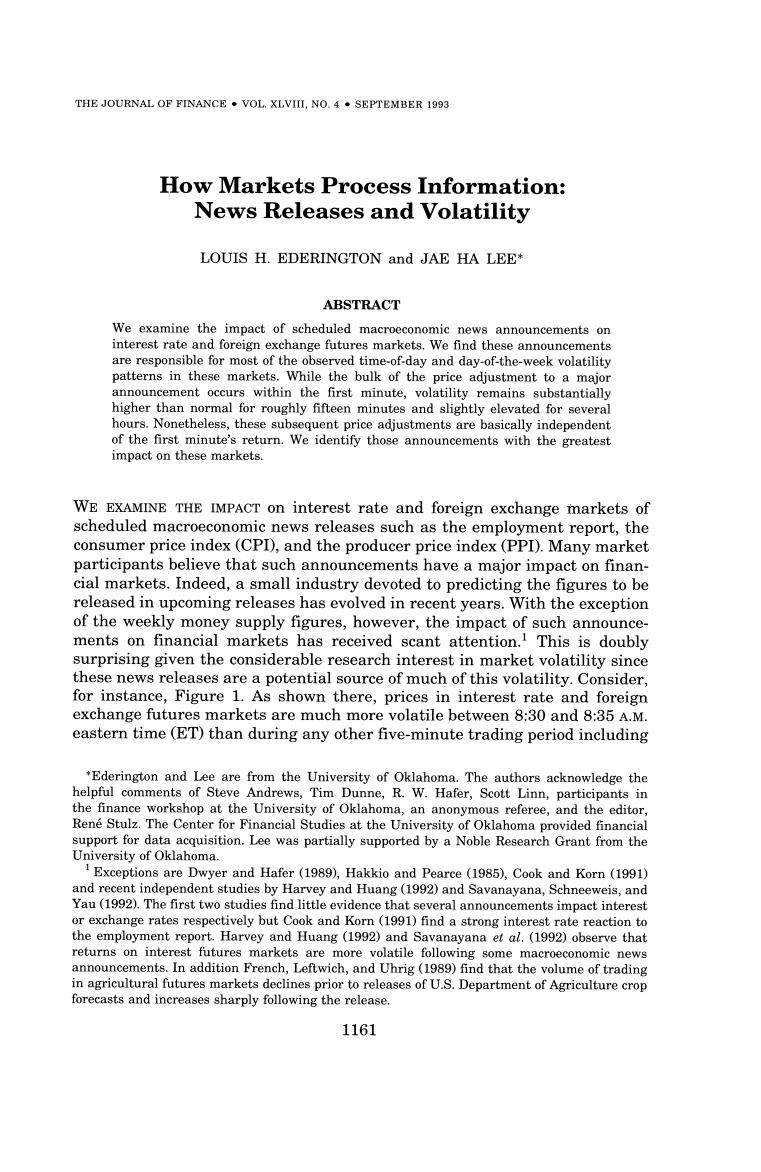
THE JOURNAL OF FINANCE VOL.XLVIII,NO.4.SEPTEMBER 1993 How Markets Process Information: News Releases and Volatility LOUIS H.EDERINGTON and JAE HA LEE* ABSTRACT We examine the impact of scheduled macroeconomic news announcements on interest rate and foreign exchange futures markets.We find these announcements are responsible for most of the observed time-of-day and day-of-the-week volatility patterns in these markets.While the bulk of the price adjustment to a major announcement occurs within the first minute,volatility remains substantially higher than normal for roughly fifteen minutes and slightly elevated for several hours.Nonetheless,these subsequent price adjustments are basically independent of the first minute's return.We identify those announcements with the greatest impact on these markets WE EXAMINE THE IMPACT on interest rate and foreign exchange markets of scheduled macroeconomic news releases such as the employment report,the consumer price index(CPD),and the producer price index(PPI).Many market participants believe that such announcements have a major impact on finan- cial markets.Indeed,a small industry devoted to predicting the figures to be released in upcoming releases has evolved in recent years.With the exception of the weekly money supply figures,however,the impact of such announce- ments on financial markets has received scant attention.This is doubly surprising given the considerable research interest in market volatility since these news releases are a potential source of much of this volatility.Consider, for instance,Figure 1.As shown there,prices in interest rate and foreign exchange futures markets are much more volatile between 8:30 and 8:35 A.M. eastern time(ET)than during any other five-minute trading period including "Ederington and Lee are from the University of Oklahoma.The authors acknowledge the helpful comments of Steve Andrews,Tim Dunne,R.W.Hafer,Scott Linn,participants in the finance workshop at the University of Oklahoma,an anonymous referee,and the editor, Rene Stulz.The Center for Financial Studies at the University of Oklahoma provided financial support for data acquisition.Lee was partially supported by a Noble Research Grant from the University of Oklahoma Exceptions are Dwyer and Hafer(1989),Hakkio and Pearce(1985),Cook and Korn(1991) and recent independent studies by Harvey and Huang(1992)and Savanayana,Schneeweis,and Yau(1992).The first two studies find little evidence that several announcements impact interest or exchange rates respectively but Cook and Korn(1991)find a strong interest rate reaction to the employment report.Harvey and Huang (1992)and Savanayana et al.(1992)observe that returns on interest futures markets are more volatile following some macroeconomic news announcements.In addition French,Leftwich,and Uhrig(1989)find that the volume of trading in agricultural futures markets declines prior to releases of U.S.Department of Agriculture crop forecasts and increases sharply following the release. 1161
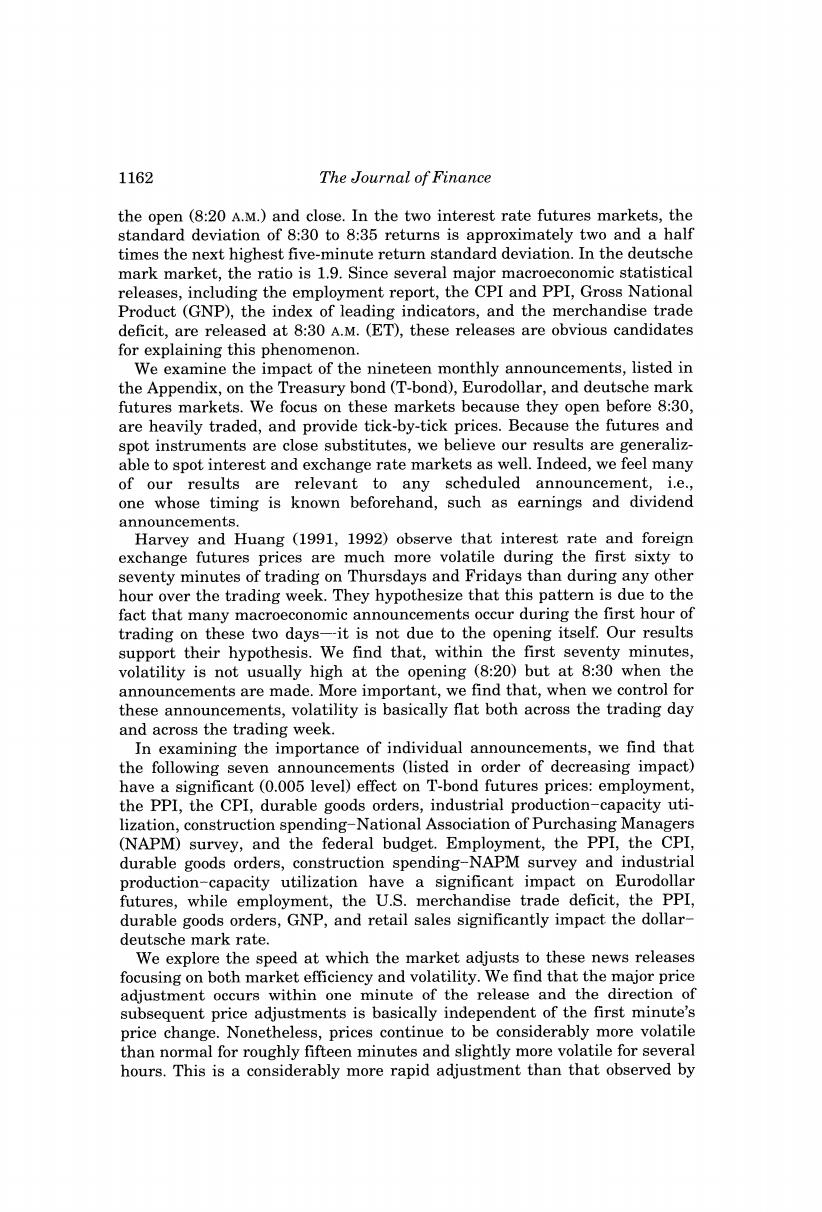
1162 The Journal of Finance the open (8:20 A.M.)and close.In the two interest rate futures markets,the standard deviation of 8:30 to 8:35 returns is approximately two and a half times the next highest five-minute return standard deviation.In the deutsche mark market,the ratio is 1.9.Since several major macroeconomic statistical releases,including the employment report,the CPI and PPI,Gross National Product (GNP),the index of leading indicators,and the merchandise trade deficit,are released at 8:30 A.M.(ET),these releases are obvious candidates for explaining this phenomenon. We examine the impact of the nineteen monthly announcements,listed in the Appendix,on the Treasury bond(T-bond),Eurodollar,and deutsche mark futures markets.We focus on these markets because they open before 8:30, are heavily traded,and provide tick-by-tick prices.Because the futures and spot instruments are close substitutes,we believe our results are generaliz- able to spot interest and exchange rate markets as well.Indeed,we feel many of our results are relevant to any scheduled announcement,i.e., one whose timing is known beforehand,such as earnings and dividend announcements. Harvey and Huang (1991,1992)observe that interest rate and foreign exchange futures prices are much more volatile during the first sixty to seventy minutes of trading on Thursdays and Fridays than during any other hour over the trading week.They hypothesize that this pattern is due to the fact that many macroeconomic announcements occur during the first hour of trading on these two days-it is not due to the opening itself.Our results support their hypothesis.We find that,within the first seventy minutes, volatility is not usually high at the opening(8:20)but at 8:30 when the announcements are made.More important,we find that,when we control for these announcements,volatility is basically flat both across the trading day and across the trading week. In examining the importance of individual announcements,we find that the following seven announcements (listed in order of decreasing impact) have a significant(0.005 level)effect on T-bond futures prices:employment, the PPI,the CPI,durable goods orders,industrial production-capacity uti- lization,construction spending-National Association of Purchasing Managers (NAPM)survey,and the federal budget.Employment,the PPI,the CPI, durable goods orders,construction spending-NAPM survey and industrial production-capacity utilization have a significant impact on Eurodollar futures,while employment,the U.S.merchandise trade deficit,the PPI, durable goods orders,GNP,and retail sales significantly impact the dollar- deutsche mark rate. We explore the speed at which the market adjusts to these news releases focusing on both market efficiency and volatility.We find that the major price adjustment occurs within one minute of the release and the direction of subsequent price adjustments is basically independent of the first minute's price change.Nonetheless,prices continue to be considerably more volatile than normal for roughly fifteen minutes and slightly more volatile for several hours.This is a considerably more rapid adjustment than that observed by
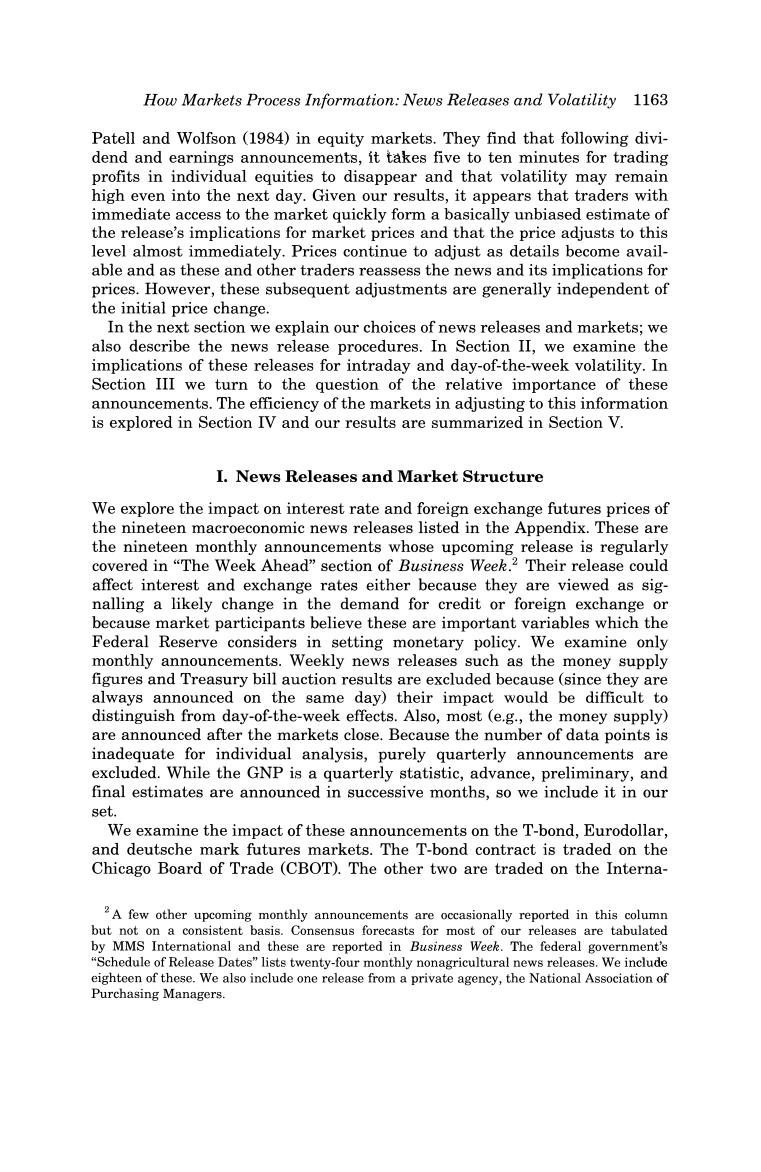
How Markets Process Information:News Releases and Volatility 1163 Patell and Wolfson (1984)in equity markets.They find that following divi- dend and earnings announcements,it takes five to ten minutes for trading profits in individual equities to disappear and that volatility may remain high even into the next day.Given our results,it appears that traders with immediate access to the market quickly form a basically unbiased estimate of the release's implications for market prices and that the price adjusts to this level almost immediately.Prices continue to adjust as details become avail- able and as these and other traders reassess the news and its implications for prices.However,these subsequent adjustments are generally independent of the initial price change. In the next section we explain our choices of news releases and markets;we also describe the news release procedures.In Section II,we examine the implications of these releases for intraday and day-of-the-week volatility.In Section III we turn to the question of the relative importance of these announcements.The efficiency of the markets in adjusting to this information is explored in Section IV and our results are summarized in Section V. I.News Releases and Market Structure We explore the impact on interest rate and foreign exchange futures prices of the nineteen macroeconomic news releases listed in the Appendix.These are the nineteen monthly announcements whose upcoming release is regularly covered in "The Week Ahead"section of Business Week.2 Their release could affect interest and exchange rates either because they are viewed as sig- nalling a likely change in the demand for credit or foreign exchange or because market participants believe these are important variables which the Federal Reserve considers in setting monetary policy.We examine only monthly announcements.Weekly news releases such as the money supply figures and Treasury bill auction results are excluded because(since they are always announced on the same day)their impact would be difficult to distinguish from day-of-the-week effects.Also,most (e.g.,the money supply) are announced after the markets close.Because the number of data points is inadequate for individual analysis,purely quarterly announcements are excluded.While the GNP is a quarterly statistic,advance,preliminary,and final estimates are announced in successive months,so we include it in our set. We examine the impact of these announcements on the T-bond,Eurodollar, and deutsche mark futures markets.The T-bond contract is traded on the Chicago Board of Trade (CBOT).The other two are traded on the Interna- 2A few other upcoming monthly announcements are occasionally reported in this column but not on a consistent basis.Consensus forecasts for most of our releases are tabulated by MMS International and these are reported in Business Week.The federal government's "Schedule of Release Dates"lists twenty-four monthly nonagricultural news releases.We include eighteen of these.We also include one release from a private agency,the National Association of Purchasing Managers
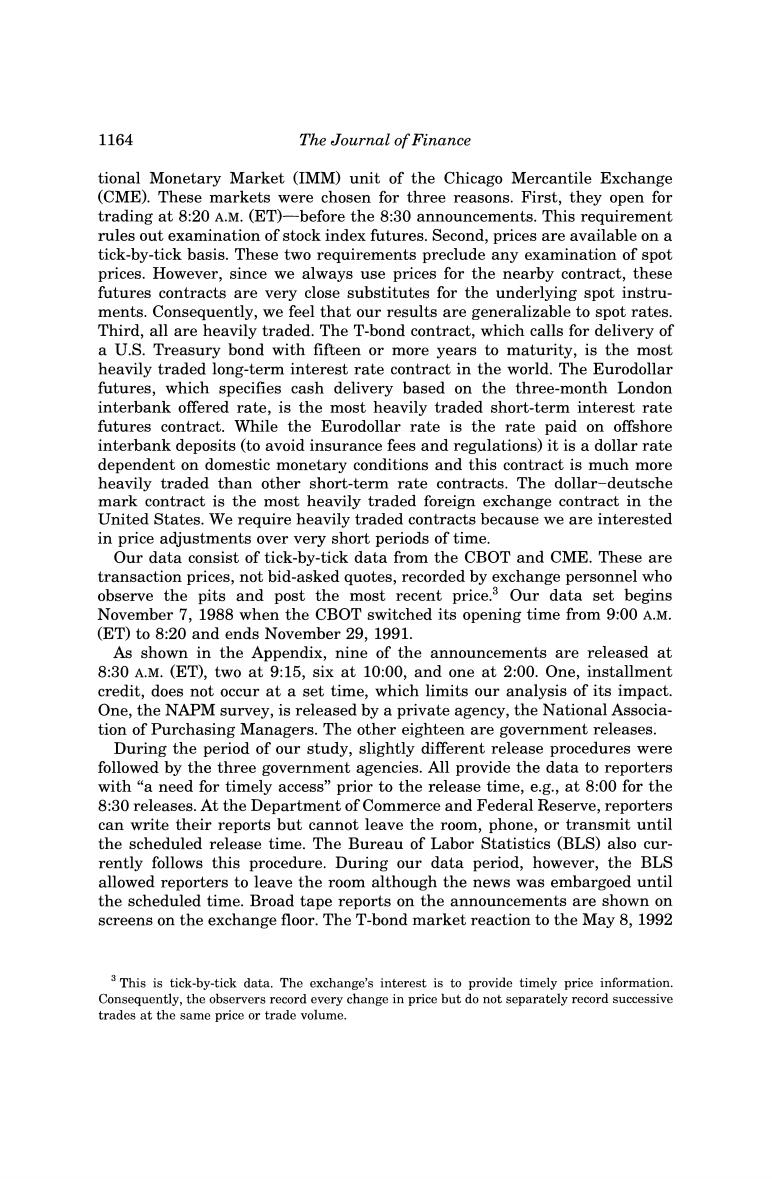
1164 The Journal of Finance tional Monetary Market (IMM)unit of the Chicago Mercantile Exchange (CME).These markets were chosen for three reasons.First,they open for trading at 8:20 A.M.(ET)-before the 8:30 announcements.This requirement rules out examination of stock index futures.Second,prices are available on a tick-by-tick basis.These two requirements preclude any examination of spot prices.However,since we always use prices for the nearby contract,these futures contracts are very close substitutes for the underlying spot instru- ments.Consequently,we feel that our results are generalizable to spot rates. Third,all are heavily traded.The T-bond contract,which calls for delivery of a U.S.Treasury bond with fifteen or more years to maturity,is the most heavily traded long-term interest rate contract in the world.The Eurodollar futures,which specifies cash delivery based on the three-month London interbank offered rate,is the most heavily traded short-term interest rate futures contract.While the Eurodollar rate is the rate paid on offshore interbank deposits(to avoid insurance fees and regulations)it is a dollar rate dependent on domestic monetary conditions and this contract is much more heavily traded than other short-term rate contracts.The dollar-deutsche mark contract is the most heavily traded foreign exchange contract in the United States.We require heavily traded contracts because we are interested in price adjustments over very short periods of time. Our data consist of tick-by-tick data from the CBOT and CME.These are transaction prices,not bid-asked quotes,recorded by exchange personnel who observe the pits and post the most recent price.3 Our data set begins November 7,1988 when the CBOT switched its opening time from 9:00 A.M. (ET)to 8:20 and ends November 29,1991. As shown in the Appendix,nine of the announcements are released at 8:30 A.M.(ET),two at 9:15,six at 10:00,and one at 2:00.One,installment credit,does not occur at a set time,which limits our analysis of its impact. One,the NAPM survey,is released by a private agency,the National Associa- tion of Purchasing Managers.The other eighteen are government releases. During the period of our study,slightly different release procedures were followed by the three government agencies.All provide the data to reporters with "a need for timely access"prior to the release time,e.g.,at 8:00 for the 8:30 releases.At the Department of Commerce and Federal Reserve,reporters can write their reports but cannot leave the room,phone,or transmit until the scheduled release time.The Bureau of Labor Statistics (BLS)also cur- rently follows this procedure.During our data period,however,the BLS allowed reporters to leave the room although the news was embargoed until the scheduled time.Broad tape reports on the announcements are shown on screens on the exchange floor.The T-bond market reaction to the May 8,1992 3 This is tick-by-tick data.The exchange's interest is to provide timely price information. Consequently,the observers record every change in price but do not separately record successive trades at the same price or trade volume